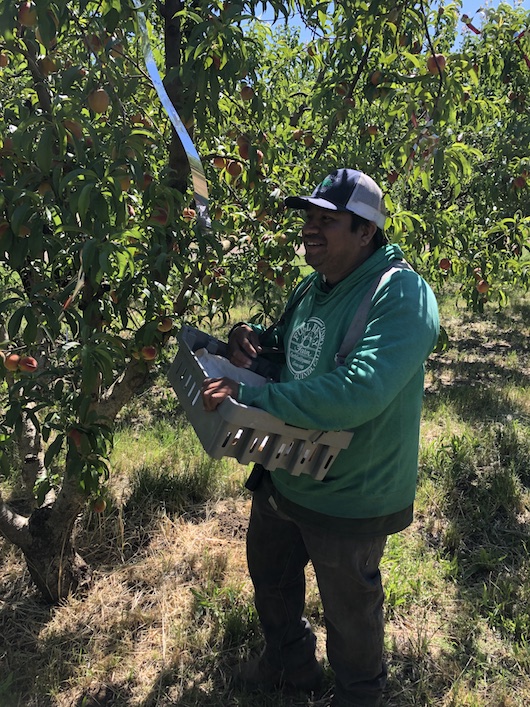
It’s really exciting to be able to include some spring fruit in your boxes this week! Who doesn’t like fruit?
There’s a fair amount of work that has to happen before we get to harvesting the fruit, as with most of our crops. Strawberry transplants go in the ground in the beginning of September and then must be weeded and tended until they start bearing a crop the next spring. So they take up valuable real estate in the field long before they start paying “rent”. Strawberry plants bear fruit for multiple years but their productivity drops dramatically after the first year, so for us, they’re a one year crop. Note: strawberry jam is back and is available on the web store!

This past month has marked a critical period for our summer and fall fruits (stone fruit like peaches and apricots; the pome fruits like apples and pears; and grapes). The fruit crew has been busy thinning these trees and vines. After harvest, it’s one of the most important fruit activities that we do, as well as one of the most labor-intensive. Thinning means removing a lot (in fact, most!) of the young fruit on a tree. It seems counterintuitive – why would we do this? Thinning improves the size and quality of fruit (higher leaf to fruit ratio – and the leaves are providing carbohydrates for the fruit to develop into sugars) and in very high yield years, it protects the tree limbs from breaking under the weight of the fruit. Additionally, when there are clusters of fruit, it can also help reduce the spread of diseases and mold caused by damp areas between those clusters.
Thinning is a time-sensitive task. If you wait too long, the benefits of thinning don’t materialize and the remaining fruits stay small. And it thinning too early isn’t a good idea either; it can be harmful for certain varieties and fruits might be too small. You’re aiming to remove small, deformed, diseased, or blemished fruit and have left the largest, best looking fruit so if they aren’t developed enough, you can’t tell! It ends up being a mid-April to mid-May activity, based on when the variety blooms. When you leave a tree after thinning, depending on the variety, peaches will be 5-7 inches apart and apricots and plums will be 3-5 inches apart. So there isn’t an exact percentage of fruit that should be left on the tree, but in years with a heavy load of fruit, our team might only leave 10%!

Thinning is a huge job and takes a lot of work, but it isn’t really an option to do it if there’s a decent amount of fruit on the trees. If we didn’t thin, we’d be left with orchards full of small, golf ball-sized peaches, which aren’t something our CSA members, farmers market customers, or other buyers want. We don’t have to thin pomegranate, persimmon, fig, citrus, or nut trees, but that still leaves us with plenty of others to take care of. It’s something that home gardeners with fruit trees can do too and there are several great guides released by University Cooperative Extension’s Master Gardener program that can provide advice.
So – a big thanks to our fruit crew (pictured above are José and Nefi) for all their thinning work now in service of great fruit later on this summer!
— Elaine Swiedler, CSA Manager
